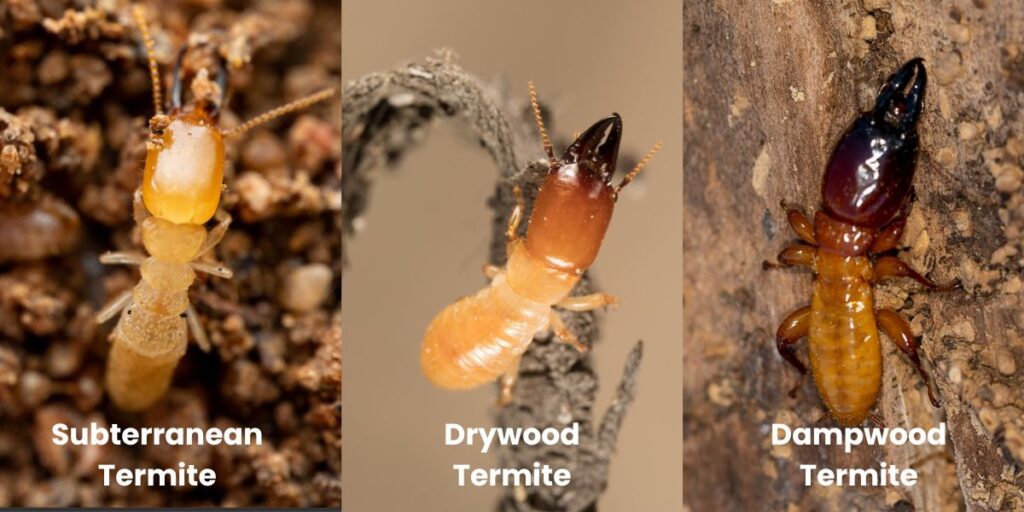Termites are a problem on every continent except Antarctica. Then again, we can’t blame them for not wanting to live there. However, in Phoenix, the climate supports the lifestyle of termites well. For this reason, it is not uncommon for homeowners to find termites in Phoenix. If you are reading this article, you’re probably looking for some advice. Perhaps on termite prevention, common species in your area, signs of an infestation, or when termites are at peak activity. Luckily, we will cover all of these topics and more in this text. Learn how you can protect your home from termites in Phoenix.

Common Species of Termites in Phoenix
It is important to know that all termite types eat wood. However, each type has its unique habits and preferred environment. Knowing about the different termite types and their habits is crucial. It can help determine where you’ll find them, the signs they leave, and the amount of damage they can cause. Termites are usually classified by their nesting habits, Drywood, Dampwood, and Subterranean Termites.
Subterranean Termites
Species: Phoenix’s most common type of Subterranean termite is the Desert Subterranean Termite (Heterotermes aureus).
Habits: These Termites need contact with the soil to survive so they create mud tubes for traveling to above-ground food sources.
Risks: These termites are eating wood 24/7! Their feeding habits paired with large colony sizes make them a highly destructive termite species. Due to Phoenix’s mild winters, they are very active year-round.
Drywood Termites
Species: The Western Drywood Termite (Incisitermes minor) is easily the most common drywood termite species in the Phoenix area.
Habits: The drywood termite does not require contact with the soil to thrive. They can live solely in the wood they are consuming and can be found in attics, furniture, or structural timbers. Drywood Termites are smaller in stature and typically have smaller colonies than the subterranean termite.
Risks: These termites can live in the wood they consume, making it harder to see signs. However, they do leave behind small pellet-like droppings called Frass near infested areas. Even though they are not as destructive as subterranean termites, they still contribute to the billions of dollars caused by termite damage each year.
Dampwood Termites
Species: The Nevada Dampwood Termite (Zootermopsis nevadensis) is the most common dampwood termite. Dampwood termites typically aren’t found in homes; instead, people see them more often in wooded areas.
Habits: As the name says, Dampwood termites prefer to live in and consume wood that is either rotted or on its way. Fortunately, Phoenix’s climate doesn’t allow for much moisture so we rarely experience these termites in Phoenix.
Risks: These termites aren’t usually found in residential settings. For this reason, the risks these termites cause are relatively low. If you have these termites in your home you probably have bigger problems like water damage and rotting wood.

Why Termites Thrive in Phoenix
Termites in Phoenix are a problem simply because of the climate. Although dampwood termites struggle to live in Phoenix, Subterranean and drywood termites thrive. Phoenix’s year-round warmth and dry climate make it easy for termites and many other pests. Additionally, other factors such as urban structures and lack of natural predators in the area are responsible for termites in Phoenix.
- Warm Temperatures: Termites are cold-blooded insects, meaning their body temp depends on their environment. Phoenix’s environment supports them well.
- Urban Structures: Due to Phoenix’s growing population there are plenty of wood-framed buildings and homes. This leads to an abundance of food sources for termites.
- Lack of Natural Predators: In urban areas, there are fewer predators for termites or rather any predators at all. This makes it easier for the termites to grow into large colonies.
Signs of a Termite Infestation
When it comes to finding signs of a termite infestation, the things you will see depend on the species of termites you have. Sure there are similarities like damaged wood but other signs will help you determine the type of termites you might have. Here are different signs of termites and the type of termite that cause them:
- Mud Tubes: These signs specifically correlate with Subterranean termites. They can be seen near foundations and basements, crawl spaces, exterior walls, attics and roof spaces, basement windows and doors, and around wooden structures.
- Discarded Wings: After termites swarm, they shed their wings. This will lead to piles of wings that are usually long, narrow, and translucent, with a pale white or light tan color.
- What is Swarming? – Swarming is a reproductive process where alates (winged termites) leave their current colony to mate and establish a new colony. This process happens once or twice per year.
- Frass: All termites produce frass (termite droppings). However, drywood termites are the only ones who will push their frass out of the area you are living in. Their frass looks like tiny, hard pellets, often similar to sand or salt grains. The color is usually light brown to darker shades of brown depending on the type of wood they have been eating.
- Damaged Wood: No matter what species you are running into, hollow-sounding wood or wood with maze-like patterns is a sign of termites.
- Blisters in wood flooring: This can indicate that termites are feeding in or below the wood.

Preventing Termites in Phoenix
Getting rid of termites is one thing but preventing them is another. Once you get them there are not any DIY solutions that work. But until then, here is what you can do to help keep them out of your home:
- Eliminate Moisture: Fix any leaky pipes or previous water damage and ensure there is the proper drainage to reduce your chances of getting termites.
- Remove Wood-to-Soil Contact: Make sure there are no exterior wood piles or large piles of paper near the home.
- Seal Entry Points: Close cracks and gaps around the foundation to ensure there are no possible entry points for termites.
Taking action against termites is the best you can do as a homeowner to keep your home safe. While these preventative measures will help reduce risks, only professional termite control can guarantee comprehensive protection.
Peak Termite Activity Periods
- Swarming Season: Termites in Phoenix are most active during the monsoon season (July-September) when humidity increases.
- Year-Round Activity: Due to Phoenix’s mild winters, termites can be active throughout the year, but may have peak activity during the warmer months.
It is best to be extra vigilant during these times of the year to keep your home termite-free.
Getting Expert Help on Termites in Phoenix
With Phoenix’s warm climate and wood-framed structures, termite activity is a constant concern for homeowners. It’s important to know about the types of termites in Phoenix and how to prevent them. Recognizing when you have termites is just as crucial. But most importantly, you should know when to call a professional. Termite problems are serious, so termite control in Phoenix is essential. While DIY methods can help, professional termite control offers complete protection. Experts can detect early signs of infestations, apply effective treatments, and provide ongoing monitoring. When choosing a service, look for licensed, experienced professionals with positive customer reviews, like AIMVO Pest Control.
If you suspect termites or want to safeguard your home, we are here to help. Our experts are ready to provide, customized treatments, and year-round monitoring. All this to keep your home termite-free. Contact us today to schedule a consultation and protect your home from termite damage.
